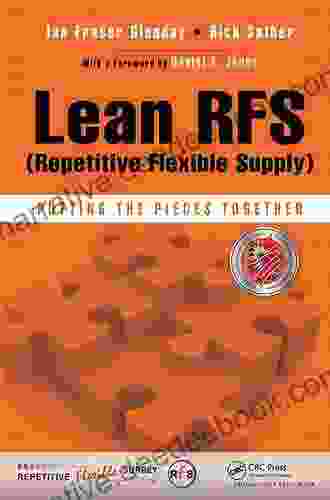Lean RFS: A Comprehensive Guide to Repetitive Flexible Supply in Manufacturing

The manufacturing industry faces constant pressure to reduce costs, improve quality, and increase flexibility in response to changing market demands. Lean manufacturing practices have emerged as a powerful tool to address these challenges. One specific approach within Lean manufacturing is Lean RFS (Repetitive Flexible Supply),which focuses on optimizing repetitive production processes.
4.5 out of 5
| Language | : | English |
| File size | : | 10489 KB |
| Print length | : | 168 pages |
| Screen Reader | : | Supported |
| X-Ray for textbooks | : | Enabled |
Lean RFS aims to eliminate waste and inefficiencies while increasing the flexibility and agility of manufacturing systems. By applying Lean principles to repetitive supply chains, manufacturers can achieve significant improvements in:
- Production efficiency
- Inventory levels
- Lead times
- Product quality
- Responsiveness to market fluctuations
Principles of Lean RFS
The principles of Lean RFS are based on the Toyota Production System and the concept of value stream mapping. Lean RFS emphasizes the following principles:
- Identify and Eliminate Waste: Waste is any activity that does not add value to the product or service, such as overproduction, waiting, transportation, and defects. Lean RFS aims to eliminate waste at every step of the production process.
- Create Flow: Lean RFS strives to create a continuous flow of materials and information throughout the production process. This involves minimizing batch sizes, reducing setup times, and eliminating bottlenecks.
- Pull Production: Instead of pushing products through the production process based on forecasts, Lean RFS uses a pull system where products are only produced when there is actual demand. This helps reduce inventory levels and improve responsiveness.
- Empower Employees: Lean RFS recognizes the importance of employee involvement in continuous improvement. Employees are encouraged to identify and address waste, suggest improvements, and take ownership of their work processes.
Implementation of Lean RFS
Implementing Lean RFS involves a structured approach that typically includes the following steps:
- Value Stream Mapping: The first step is to map the current production process to identify areas of waste and inefficiency. This involves creating a visual representation of the flow of materials, information, and time throughout the process.
- Waste Identification: Using the value stream map, the team identifies and classifies waste into seven categories: overproduction, waiting, transportation, overprocessing, inventory, defects, and underutilized employee potential.
- Root Cause Analysis: For each type of waste identified, the team investigates the underlying causes and develops countermeasures to address them.
- Process Redesign: The team redesign the production process to eliminate waste and create flow. This may involve changes to layout, equipment, work instructions, and supply chain management practices.
- Continuous Improvement: Lean RFS is an ongoing process of continuous improvement. The team regularly monitors performance, identifies new opportunities for improvement, and implements changes to enhance the system.
Benefits of Lean RFS
Implementation of Lean RFS can bring numerous benefits to manufacturing organizations, including:
- Reduced Production Costs: Elimination of waste leads to significant cost savings in areas such as inventory, labor, and machine downtime.
- Improved Quality: Continuous improvement and waste elimination result in higher quality products.
- Shorter Lead Times: Faster production flows and reduced setup times reduce lead times, improving responsiveness to customer demand.
- Reduced Inventory Levels: Pull production minimizes inventory levels, freeing up capital and reducing holding costs.
- Increased Flexibility: Lean RFS improves the ability of manufacturers to adapt to changing market demands, such as product variations or fluctuations in demand.
- Improved Employee Morale: Employee involvement and empowerment lead to higher job satisfaction and increased productivity.
Lean RFS is a powerful manufacturing strategy that can help organizations achieve significant improvements in efficiency, flexibility, and profitability. By applying Lean principles to repetitive production processes, manufacturers can eliminate waste, create flow, and empower employees to drive continuous improvement. As a result, they can gain a competitive advantage in today's dynamic and demanding manufacturing environment.
4.5 out of 5
| Language | : | English |
| File size | : | 10489 KB |
| Print length | : | 168 pages |
| Screen Reader | : | Supported |
| X-Ray for textbooks | : | Enabled |
Do you want to contribute by writing guest posts on this blog?
Please contact us and send us a resume of previous articles that you have written.
 Novel
Novel Page
Page Chapter
Chapter Text
Text Story
Story Reader
Reader Magazine
Magazine Newspaper
Newspaper Paragraph
Paragraph Bookmark
Bookmark Shelf
Shelf Glossary
Glossary Bibliography
Bibliography Preface
Preface Synopsis
Synopsis Footnote
Footnote Codex
Codex Bestseller
Bestseller Classics
Classics Library card
Library card Narrative
Narrative Biography
Biography Reference
Reference Encyclopedia
Encyclopedia Thesaurus
Thesaurus Character
Character Resolution
Resolution Librarian
Librarian Catalog
Catalog Stacks
Stacks Study
Study Research
Research Reading Room
Reading Room Rare Books
Rare Books Literacy
Literacy Storytelling
Storytelling Awards
Awards Reading List
Reading List Theory
Theory Textbooks
Textbooks Gary Mottram
Gary Mottram Dana Landers
Dana Landers Anjali Sebastian
Anjali Sebastian Sylviane Granger
Sylviane Granger Giuseppina Pellegrino
Giuseppina Pellegrino Yannick Haenel
Yannick Haenel Max Ehrlich
Max Ehrlich Fred Campano
Fred Campano Sarah Burns
Sarah Burns J Zachary Pike
J Zachary Pike Lay Hwee Yeo
Lay Hwee Yeo Naushad Sheikh
Naushad Sheikh Crystal Schwanke
Crystal Schwanke Eric Macintosh
Eric Macintosh Elizabeth Hoyt
Elizabeth Hoyt Max Scratchmann
Max Scratchmann Yonas Gorfe
Yonas Gorfe William Stewart
William Stewart William Damon
William Damon Ford Harding
Ford Harding
Light bulbAdvertise smarter! Our strategic ad space ensures maximum exposure. Reserve your spot today!

 Winston HayesFocused and Fearless: My Everyday Journal for Unlocking Your Potential and...
Winston HayesFocused and Fearless: My Everyday Journal for Unlocking Your Potential and...
 Richard WrightEdward Said's Legacy of Emancipation and Representation: A Journey Through...
Richard WrightEdward Said's Legacy of Emancipation and Representation: A Journey Through... Brennan BlairFollow ·16.6k
Brennan BlairFollow ·16.6k Enrique BlairFollow ·15.6k
Enrique BlairFollow ·15.6k Floyd PowellFollow ·16.2k
Floyd PowellFollow ·16.2k Roald DahlFollow ·14.9k
Roald DahlFollow ·14.9k Elliott CarterFollow ·2.6k
Elliott CarterFollow ·2.6k Cameron ReedFollow ·9.6k
Cameron ReedFollow ·9.6k Dennis HayesFollow ·4.4k
Dennis HayesFollow ·4.4k Deacon BellFollow ·10.9k
Deacon BellFollow ·10.9k

 Dallas Turner
Dallas TurnerParasols and Peril: Adventures in Grace
In the quaint town...

 Caleb Carter
Caleb CarterFlight Attendant Joe: A Dedicated Professional in the...
Flight Attendant Joe...

 Jerry Ward
Jerry WardPick Lottery The List For 23 States August 15 2024
The Pick Lottery is a multi-state lottery...

 Hudson Hayes
Hudson HayesHow the Media Wields Dangerous Words to Divide a Nation
In a world where the media is...

 Curtis Stewart
Curtis StewartThe Magic Mala: A Story That Changes Lives
In the realm of ancient traditions and...

 Raymond Parker
Raymond ParkerEarthly Meditations: A Poetic Tapestry of Nature,...
In the realm of contemporary...
4.5 out of 5
| Language | : | English |
| File size | : | 10489 KB |
| Print length | : | 168 pages |
| Screen Reader | : | Supported |
| X-Ray for textbooks | : | Enabled |







